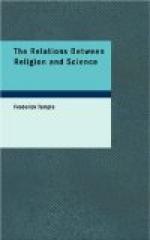And this conviction of personal identity will presently be found to fall in with the revelation of the Moral Law, which is my subject in this Lecture. For it is by virtue of this personal identity that I become responsible for my actions. I am not merely the same thinking subject, I am the same moral agent all through my life. If I changed as fast as the phenomena of my being changed, my responsibility for any evil deed would cease the moment the deed was done. No punishment would be just, because it would not be just to punish one being for the faults of a totally different being. The Moral Law in its application to man requires as a basis the personal identity of each man with himself.
If corroboration were needed of the directness of the intuition by which we get this idea of our own personal identity, it would be found in the entire failure of all attempts to derive that idea from any other source. Comte, the founder of the Positive School, can do nothing with this idea but suggest that it is probably the result of some obscure synergy or co-operation of the faculties. John Stuart Mill passes it by altogether as lying outside the scope of his enquiries and of his doctrine. Mr. Herbert Spencer deals with it in a very weak chapter[1] of his remarkable volume of First Principles. He divides all the manifestations made to our consciousness, or, as we commonly say, all our sensations, into two great classes. He selects as the main but not universal characteristic of the one class, vividness; of the other class, faintness; a distinction first insisted on, though somewhat differently applied, by Hume. He adds various other characteristics of each class, some of them implying very questionable propositions. And we come finally to the following astonishing result. Sensations are divided into two classes; each has seven main characteristics which distinguish it from the other. One of these classes




